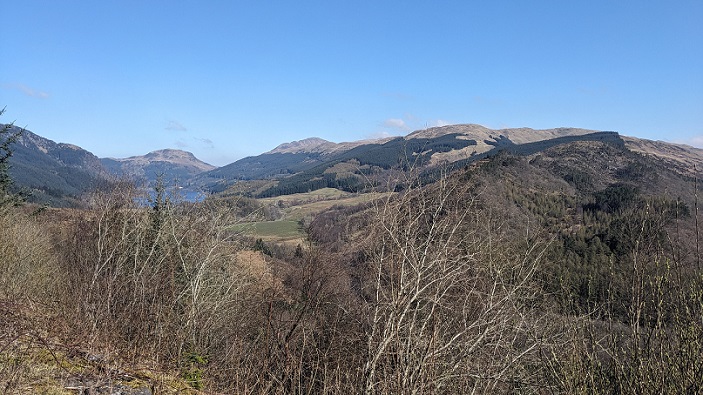
Forest and Land Scotland (FLS)’s landholding Strathyre, which runs north from Callander to Balquhidder, provides perhaps the best example of mixed woodland in the Loch Lomond and Trossachs National Park. It is also one of the few near examples we have in Scotland to Continuous Cover Forestry (see here for explanation). Among the main species of tree found there are ash, beech, birch and oak and conifers grown for commercial purposes: Scots Pine, Norwegian Spruce, Douglas Fir, Sitka Spruce, Noble Fir, European, Japanese and hybrid larch.
The creation of this mixed woodland owed much to its former Chief Forester and author, Don MacAskill. He resided in the strath and, as the Herald obituary (see here) put it, “played an influential part in scenic and ecological planting where commercial plantations were fringed by deciduous trees or had clumps of mixed species inserted in suitable spots and where the needs of wildlife were taken into account”. Strathyre has become, as a consequence, one of the best places for wildlife in the Loch Lomond and Trossachs National Park. Among the breeding species found there are red squirrels and a range of raptors, including red kite, sparrowhawk, buzzard and goshawk. Goshawk, still one of Scotland’s rarest birds (see here), have colonised the area in the last ten years and nest and hunt among mature trees.

This context is crucial for understanding the implications of Forest and Land Scotland’s Larch Removal Plan (LRP) for Strathyre which was produced at the start of 2025. The plan appeared on Scottish Forestry’s register of statutory consultations on 21st April, under the Perth and Argyll Conservancy, and is open for responses by the public for 28 days. All the documents relating to the plan are on the FLS website (see here) and responses should be sent to panda.cons@forestry.gov.scot).
Why FLS are proposing to remove larch from Strathyre
The ostensible justification for the LRP lies in the relatively new tree disease, phytopthera ramorum. This was first reported in 1995, was subsequently found to have originated in South East Asia and was carried by human activity from there to both Europe and America (see here). It has been found to affect a large range of plants, including bilberry. Forest Research report that in 2009 it was found to have infected larch which cover about 154,000 hectares, or five per cent of Great Britain’s total woodland area (see here).
In order to try and stop the spread of the disease the Forestry Commission, as it then was, started to issue Statutory Plant Health Notices (SPHNs) requiring infected larch plantations to be felled. It hasn’t worked and phytopthera ramorum has spread up north from the Galloway Forests through Argyll and the Trossachs as a far north as Inverness and Aberdeen (see here for outbreak map).
The Strathyre LRP reports that “in 2016, a first infection of the disease Phytophthora ramorum was discovered within Strathyre” but there was NO mention of this in the West Strathyre Land Management Plan (LMP) for 2017-27 (see here) and no action planned. The LMP did note, however, that “an attack of Phytophthora ramorum or other disease on these mature hanging stands in areas of high visual impacts would potentially be very damaging from a landscape perspective and very hard to ameliorate.” Since then Scottish Forestry has issued a number of SPHNs for Strathyre including to neighbouring landowners.
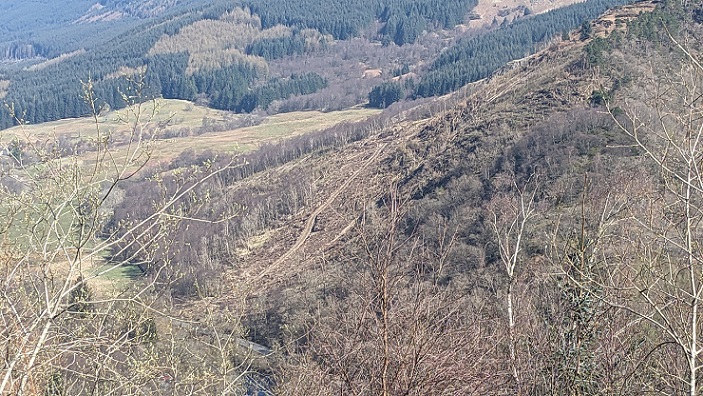
The reason FLS now wants to take action does not appear to be because of the SPHNs, a number of which have been issued by Scottish Forestry for the area over the last nine years. They still only cover a small proportion of the larch. Nor can it be because “Recent experience from elsewhere in Central Region indicates that the Strathyre Forests will suffer an exponential increase in Phytophthora ramorum infections over the next five years”, as FLS claim, since there is no evidence that the spread of phytophera ramorum will be halted by felling larch.
Rather, part of the explanation appears to lie in growing concerns that the disease could spread into Sitka, the commercial forestry industry’s tree of choice. If that happens, it could devastate timber production in Scotland and would have severe consequences for FLS, which is now dependant on the sale of Sitka for much of its revenue. But there also appear to be other factors at play.
FLS’ proposals
“The Strathyre Forests Larch Removal Plan (LRP) covers a total of 4224.65 ha located around the
villages of Strathyre and Balquhidder in Stirlingshire. The LRP area is divided in 3 forest blocks.
These being Kirkton block (~471.52 ha) above Loch Voil, the West Strathyre block (~2630.68 ha)
on the West side of Loch Lubnaig and Strathyre East (~1122.45 ha) on the East side.”
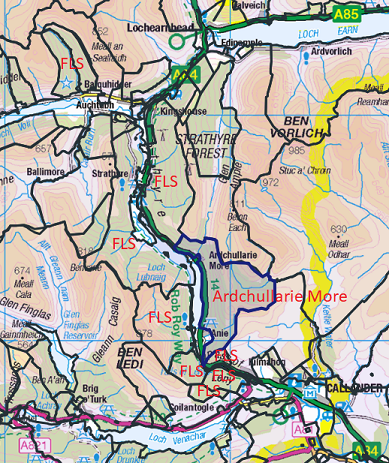
FLS is proposing, however, to fell not just the larch but a much larger area of mature trees around them. For example, Table 1 of Operations, contained in Appendix 1 to the plan (see here), shows that in the West Strathyre block a total are of 568.58ha of trees will be clearfelled or thinned of which less than a quarter (123.5 ha) are larch. It is the same in the other two blocks.
Part of the explanation for this is that larch are scattered across Strathyre, a consequence of Don MacAskill and his colleagues being determined to plant the right tree in the right place and create mixed woodland:
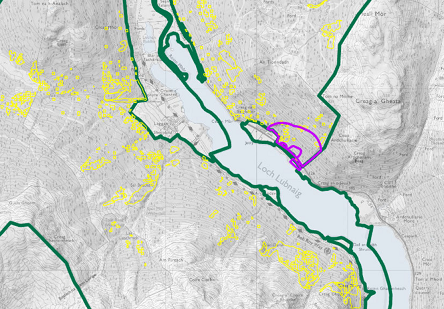
But its also because selective felling, which is used in Continuous Cover Forestry, is anathema to FLS which favours clear felling large areas with big machines as, whatever the environmental costs, it is cheaper financially.
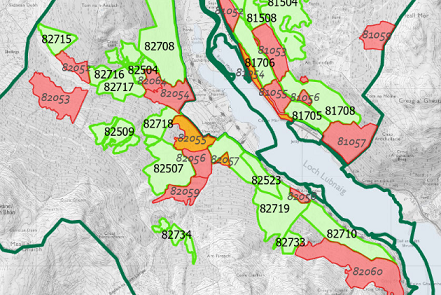
As a consequence, FLS is proposing that “where the larch component remains minimal (usually less than 8%) in previously un-thinned or in coupes where the thinning window has been missed, larch will be either felled to recycle or chemically killed with a minimal felling of other conifers to allow access to pockets of larch, where required”. In other words FLS is not even proposing to harvest the uninfected larch but rather rather poisoning it or leaving it in place once felled. What a waste!

Once an area is thinned or clearfelled, it can expose more trees around it to windthrow,and FLS are using that as a reason to fell even more trees:
“where thinning and keyholing of larch is expected to cause an unacceptably high risk of windblow, especially on the upper slopes of these forests, clearfell has been selected as the preferred management option.”
The LRP has a section headed “Restocking proposals/natural regeneration” which says nothing about natural regeneration! Instead, as currently phrased (see below) it appears FLS is proposing to restock all the felled areas by re-planting, mainly by replacing the larch and other single species stands with “mixed conifers” (though how this fits with the proposal to replace like with like is unclear):
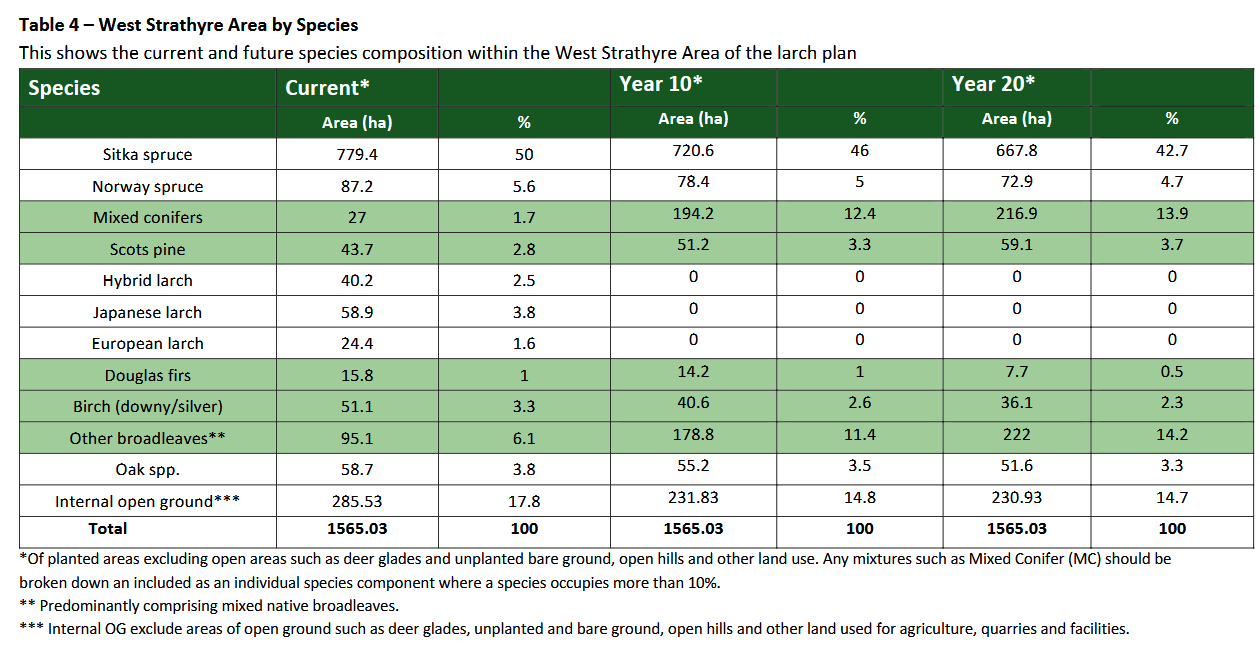
The positive aspect of this plan is it would maintain the model of a mixed species forest, with a reduction in the area covered by Sitka and an increase in the area covered by “Mixed Conifer” and “Other broadleaves”. However, the proposals will also have a very significant impact on the age structure of the trees on FLS’ landholding in Strathyre:
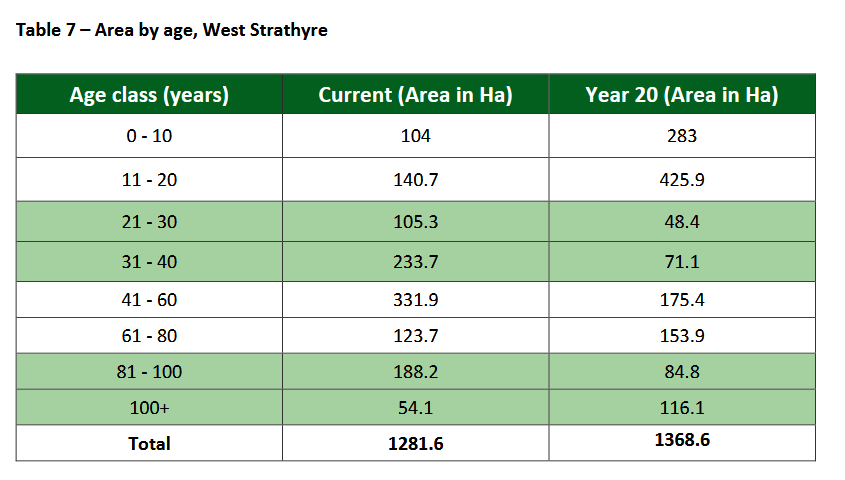
Currently, most of the trees (1029.8 out of 1281.6 ha) are over 30 years old but FLS is proposing to change that dramatically so that in twenty years time only 601.3 ha or less than half of the trees will be over 30 years old.
The consequences of FLS’ plans for wildlife and the natural environment
Few of the conifers in Strathyre are very old – there are a few survivors from 19th planting – but a large proportion are now of an age when they start becoming particularly important for wildlife. The LRP acknowledges this in a short section headed “biodiversity”:
Stands of mature conifer, including larch, are particularly valuable for a range of species including red squirrel and bird of prey. Loch Lubnaig and the major connecting waterbodies, and the Loch Lubnaig Marshes are designated as an SAC and SSSI respectively for a range of aquatic life, including fish
assemblages and freshwater pearl mussels.
The LRP, however, makes no attempt to assess the populations of these important species or HOW they will be affected by FLS’ proposals. Moreover, the plan states “no projects are proposed at this stage which require an EIA SOR” (Scoping Opinion Request from Scottish Forestry). That exploits a gap in the current regulations which require an EIA to be considered for most “afforestation” or “deforestation” in a National Park but excludes felling and restocking proposals, whatever the impact (see here).
The impact of felling so many of the middle-aged conifers on wildfire is likely to be profound. Consider, for example, the impact of FLS’ proposals on seed production, on which species like crossbill and red squirrel depend, in Strathyre. NatureScot issues a general license to FLS for managing red squirrel during forest operations (see here). The license states that a viable population of squirrels should contain 125 individuals and the table below shows the densities of red squirrels per ha for different tree species:
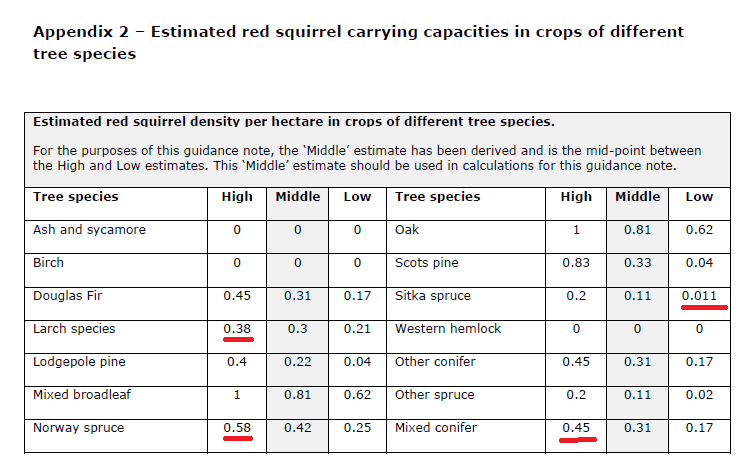
First you need to consider at what age various conifers start to produce seed. Sitka, for example, starts to produce seed when 20-25 years old and then does so every 4-8 years while Norwegian Spruce starts to do so when 30 years old. But then you need to consider the nutritional value of the seeds, with Sitka’s tiny seeds providing much less food than the bigger seeds of Norwegian Spruce (Scots Pine is better still). While the Table quotes a top carrying capacity for Sitka higher than what the source paper detailed, in a poor cropping year you would need 11,363ha (about the size of the city of Edinburgh) to sustain a population of 125 squirrels!
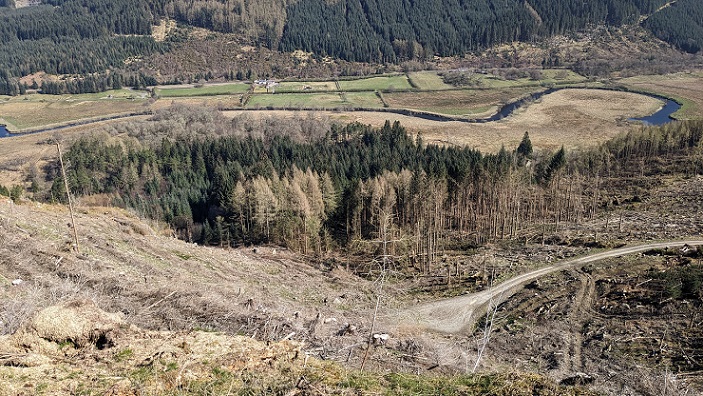
FLS’ felling proposals will also serve to create more isolated blocks, reducing the connectivity of the woodland and making it harder for red squirrels to range across the area. FLS appear to have given no consideration to that as they are required to do under the terms of their license with NatureScot.
Two other potential environmental impacts of the LRP are worth highlighting.
First, as a consequences of ash dieback which is now well-established in Strathyre, FLS is also seeking permission to fell ALL ash trees located by utilities (such as powerlines) and trees along access routes.
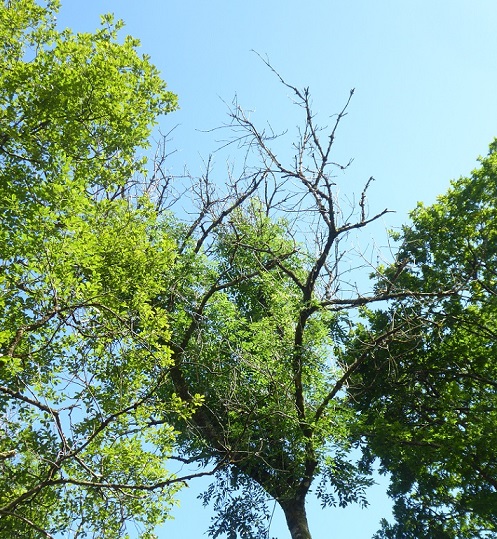
Second, their restocking proposals do not explain how they will address the threat from the Large Pine Weevil which “can destroy an average of 50 per cent of young, planted conifer trees on a restocked site where they are unprotected” (see here).
The problem is caused in part because the Pine Weevil can live on in the stumps of felled trees for up to five years and rapid restocking has become the current practice, rather than leaving an area fallow for a period which used to happen previously, puts new trees at risk. From the LRP it appears FLS is planning to restock some of the clearfelled areas within two years The unanswered question is whether as a result FLS intends to use pesticides, like the highly polluting gazelle (see here), to kill the pine weevil. If so, there would be serious implications for the watercourses and Loch Lubnaig which form part of a Special Area of Conservation and are supposed to be protected for their aquatic life.
The response of public authorities to FLS’ proposals
I have criticised the Loch Lomond and Trossachs National Park’s Trees and Woodland Strategy 2019-39 (see here), several times in the past (see here), (here) and (see here). While it should be influencing how forestry in places like Strathyre is managed, it has nothing useful to say. FLS is not mentioned once, although it is by far the biggest landowner in the National Park and as a consequence has been responsible for the collapse in nature which the LLTNPA claims (see here) it wishes to tackle. There is not a single reference in the strategy to Continuous Cover Forestry and just one reference to creating more mixed woodland, albeit nothing about how this will be achieved. Moreover, the Strategy endorses the UK Forestry Standard which is driven by the needs of commercial forestry interests rather than nature.
While FLS has consulted the LLTNPA’s Trees and Woodland Adviser (Appendix 4 to consultation), it is hardly surprising given this background that they had nothing to say about the impact of the LRP on wildlife: “Regarding the restocking however, adviser encouraged the inclusion of broadleaves
along the southern edge to buffer Balquidder village”. As a result of this representation “FLS reports that It has been agreed with SF that restocking will be a “like -for like” from the original plans to give FLS more time to design appropriate restocking plans. FLS acknowledge that the restocking proposal is outdated and does not reflect UKWAS (UK Woodland Assurance Scheme – a voluntary code] and wider LLNP objectives.” While an unacknowledged consequence of a delay in restocking could be avoid the use of gazelle to eradicate pine weevil, it appears that neither raptors nor red squirrel are of any consequence to the LLTNPA.
The response to the LRP consultation from NatureScot, the body which has statutory responsibility for protecting rare species as well as protected areas, is no better. There is no mention of red squirrels, even though NatureScot has the power to protect them by withholding felling licenses, or of raptors:
“Plan successfully acknowledge designated sites. Measures should be taken to secure that no significant run-off/siltation can enter the catchment as a result of these works and that any run-off /siltation which could reach a watercourse as a result of these works. In order to do this NS strongly recommend the creation of a comprehensive pollution control plan and/or water quality management
plan”.
Its been left to the volunteers in the form of the local raptor study group to express concerns about these proposals:
“The Central Scotland Raptor Study Group is very concerned about these proposals, especially if as elsewhere in Queen Elizabeth Forest Park, they also involve felling substantial other areas of mature long tern conifer retentions. Concerns whether areas of Continuous Cover Forestry (CCF) being
retained to ensure that important raptor sites in this area are protected”.
No responses have been recorded as yet from the major voluntary organisations with an interest in nature in the National Park: the Scottish Wildlife Trust, which leads “Saving Scotland’s Red Squirrels” (see here); the Woodland Trust, which manages Glen Finglas, just over Ben Ledi to the west and which is part of the Trossachs Nature Nature Reserve; or the RSPB. I do, however, know that RSPB, at least, has been expressing concerns to FLS about the proposals.
FLS’ Larch Removal Plan and its mismanagement of the National Forest Estate
I hope that the local residents of Strathyre, regular visitors and those who are concerned about the state of nature in the National Park will consider lodging objections to the LRP to FLS (enquiries.central@forestryandland.gov.scot) and to the Perth, Argyll and Central Scotland Conservancy of Scottish Forestry (panda.cons@forestry.gov.scot).
The wider context, however, is the increasingly commercial approach of Forest and Land Scotland as a result of continued austerity and since responsibility for managing the National Forest Estate was devolved to the Scottish Government. FLS’ main imperative now, besides helping to meet the Scottish Government’s tree planting targets, is to raise income from timber sales. Its budgets for conservation and outdoor recreation have been slashed and those activities are now supposed to pay for themselves – hence their abandonment of their campsite at Sallochy (see here). FLS now has very little interest in using the National Forest Estate to provide habitats for wildlife – if sitka was allowed to grow old, as it does on the west coast of America, it might actually fulfil that function – and the suspicion is that in Strathyre it is using phytopthera ramorum in larch as an excuse to fell other trees with high timber value to help plug its budget deficit.
That situation is unlikely to change so long as the current model of forest management, as practised by FLS, and where it is expected to compete with commercial companies remains in place. For Strathyre the rot started to set in when responsibility for making decisions was moved from local foresters, based in the local office, to Aberfoyle. It then became worse as accountants replaced foresters and contractors replaced local staff who knew and cared about the places they worked. The Strathyre LRP illustrates the need for fundamental reform not just of the LLTNPA but FLS too.
And this post hasn’t even consider the impact of FLS’ proposals on landscape or outdoor recreation………….!

In addition, there is mounting evidence of the important role of soil fungi in capturing and storing carbon. Clear felling can result in the release of substantial amounts of carbon back into the atmosphere and causes great damage to the mycorhyzal communities required to support healthy tree growth.
Find an alternative this will be carosphorphic for wildlife and tlocal businesses